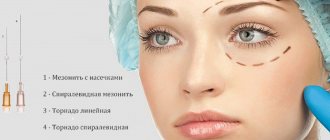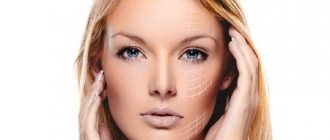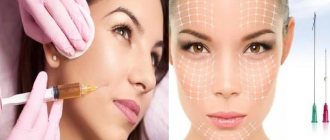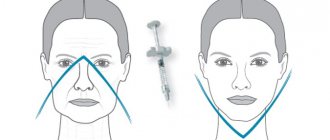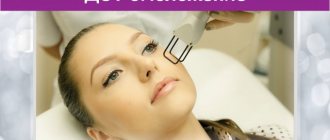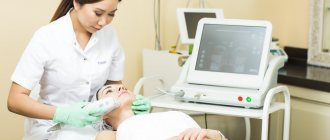In contrast to the full-fledged plastic surgery “classic facelift” with its indispensable attributes: deep surgical intervention, skin excision and a long rehabilitation period, today there is the most gentle procedure for thread skin tightening.
One of the most common on the domestic market is the lifting technique using certified Aptos threads. Reviews about this procedure are very different: from admiring to negative. Is there a “golden mean”?
Thread lifting - for cosmetology and plastic surgery
The doctor offered specialists in the field of aesthetic medicine, plastic surgery, cosmetology and dermatology a method that had never existed before. Before the appearance of Aptos threads in the direction of dermatocosmetology, there were injections and many other fairly simple methods to help an already young patient look younger. And plastic surgery - which provided a radical solution for older patients, and at the same time required skin incisions and tissue distribution. Between these areas there were no intermediate methods and transitional procedures for the patient’s transition from dermatocosmetology to surgery without serious surgical and surgical intervention.
It was APTOS that linked these two areas together and gave the world a method of effective non-surgical thread lifting.
The APTOS company gave impetus to the development of aesthetic medicine and laid the foundation for the mass production and use of lifting threads, which gave rise to the spread of threads from other manufacturers.
3D Mesothread System ↑
Separately, it is worth mentioning the use of so-called mesothreads as a lifting base, which are distinguished by their relatively low cost and good effect. Mesothread is a common suture surgical cord consisting of biocompatible polydioxanone.
Video demonstration of the method and result:
A special feature of the use of mesothreads in lifting is the non-standard method of insertion: the thread is pulled between the tissues using a special flexible steel needle, up to 0.3 mm thick. This allows you to do without fixing notches (the mezzanine itself is absolutely smooth), and also allows the cosmetologist to more comfortably control the process of laying the reinforcing thread.
As a result, mesothreads can correct more complex areas where conventional wire cannot be strengthened. The further mechanism of action of any mesothread is similar to the mechanism of conventional absorbable threads. Polydioxanone decomposes without a trace within one year. The method of inserting mesothreads is surgically more complex and traumatic, but it has its admirers who leave positive reviews.
Benefits of thread lifting
Compared to plastic surgery, Aptos lifting threads have a number of significant advantages:
- Does not require surgery or general anesthesia
- The threads are inserted under the skin under local anesthesia, using a non-invasive method that does not require incisions - this greatly facilitates and shortens the rehabilitation process.
- There are virtually no contraindications or side effects compared to surgical facelift
Since thread lifting requires only a small puncture with a needle, after which a thread is inserted, and no incisions are required, there are no surgical traumatic consequences. Due to this, rehabilitation takes much less time.
Initially, implantation of Aptos threads was carried out mainly for non-surgical facelift. Then other areas were added, and today, with the use of Aptos threads, you can remove a double chin, tighten the skin on the neck, chest, abdomen, legs and other areas.
Indications and contraindications for the use of mesothreads
Before deciding on the procedure, experts advise you to carefully read the possible risks, weigh the pros and cons, and most importantly, consult a doctor about contraindications.
The first thing you should pay attention to is age. It is strictly not recommended to use mesothreads before the age of 35: collagen is produced in sufficient volume, and additional intervention will lead to an excess of its fibers. Simply put, an unnatural relief may appear on the face, which will turn the features into an ugly hypertrophic mask.
There are also standard restrictions common for most cosmetic procedures:
- diabetes;
- allergies to the drugs used;
- poor blood clotting;
- oncology;
- pregnancy and breastfeeding;
- infections and inflammations.
The use of mesothreads is recommended when other methods do not give the expected effect. Both men and women undergo the procedure, the main thing is to trust a professional: the slightest awkward movement can distort the oval of the face.
Indications for the use of mesothreads:
- deep wrinkles and sagging oval face;
- drooping corners in the eyebrow area;
- sagging skin;
- other changes due to aging.
The result lasts for 1.5-2 years, after which it is necessary to either repeat the procedure or constantly maintain the result with the help of physiotherapy and creams with a lifting effect.
Application of Aptos threads in other areas of medicine
After their invention, APTOS threads proved themselves so well that they became widespread not only in plastic surgery, but also in general surgery - they began to be used for suturing wounds, achieving better results than with the material used previously. For the same purpose, Aptos threads began to be used in gynecology, urology, orthopedics, and traumatology.
Aptos threads are also used in plastic surgery for operations performed using classical methods. Threads can be combined with other aesthetic cosmetology techniques - for example, with fillers and other cosmetic procedures, including most hardware ones.
Aptos threads - rehabilitation period
If after the procedure of bioreinforcement with Aptos threads you can go to work almost immediately, then after lifting you will need several days to recover. In rare cases, this period extends to 1.5 weeks. At this time it is observed:
- Some “gathering” of the skin, which gradually straightens out and the visual tubercles along the threads disappear;
- Small hematomas (especially in women who smoke due to the fragility of the vessel walls). They also pass within a few days;
- Pain that can be relieved with prescribed medications;
- Feeling of skin tightness.
No post-operative procedures or compression bandages are provided. Sudden facial movements and massage are contraindicated for two to three weeks. During this time, cosmetic procedures are also prohibited.
Back to the beginning of the article
First and second generation of APTOS threads
More than 20 years have passed since the invention of the first generation of Aptos threads - the method has gone through a long path of formation and development, from invention to implementation in practice, obtaining results and monitoring them for many years.
The knowledge and experience accumulated over the years has allowed the APTOS company to further improve the methods of thread lifting - thus, a certain “ideal formula” has appeared at the disposal of aesthetic medicine.
The second generation of threads was so popular among inventors and aestheticians around the world that the first generation was gradually completely forgotten - since the second generation was simpler, gave better results, fewer nuances and complications. This was truly a significant step forward.
The development of the second generation of threads proceeded at a rapid pace - the production of threads for various purposes began. Some of them were intended for both plastic surgeons and dermato-cosmetologists.
In 2012, the APTOS company introduced the world to even more modern threads - Aptos Excellence Visage - they are used all over the world and there is no analogue of this product in the world today.
These threads do not require specific installation; no complex turns with a needle under the skin, knots, etc. are required. It is very simple to perform and gives excellent results - such as with a surgical lift. This method is still popular today, but manufacturers did not stop there and at a new stage of development began to use smaller, shorter and thinner threads.
Aptos threads - negative reviews
Domestic cosmetologists and plastic surgeons have been using the Aptos thread lift method for skin rejuvenation for about 20 years. Despite the large number of reviews from grateful clients, quite often you can find cautious or even angry comments from people who are dissatisfied with the result of the operation or suffer from complications. What is this connected with?
One of the most important risk factors is the wrong choice of clinic and doctor.
The authors of the Aptos method, Georgy Marlenovich Sulamanidze and Marlen Andreevich, conduct training and issue certificates only to dermatologists who have a higher education document. Therefore, when contacting a clinic, you need to make sure not only of the doctor’s competence, but also that he has a certificate that allows him to perform thread bioreinforcement or skin tightening with Aptos threads.
Mastery of cannulas (blunt-pointed needles made of high-quality surgical steel to which Aptos threads are attached) does not guarantee highly qualified medical care. Sometimes girls complain that they are bothered by significant swelling after surgery with a bluish tint.
Others notice
- facial asymmetry,
- surface roughness,
- hematomas
- or even subcutaneous inflammation
– this is not a complete list of troubles associated with the doctor’s unprofessionalism. In girls with very thin, fair skin, the threads themselves may be noticeable.
Another important factor in the appearance of negative reviews about Aptos threads is the low quality of unregistered samples of suture material, which does not have an official certificate from Roszdravnadzor.
It must be remembered that unscrupulous doctors can save on threads made in Asia.
The third factor in the occurrence of various side effects can be considered the individual characteristics of individual patients. If the doctor is not informed about the presence of allergies, the reactions of which he can prevent by prescribing antihistamines, as well as a number of other diseases, then the consequences of even a low-traumatic surgical intervention can be complicated.
However, you shouldn’t be afraid of all the possible side effects, you just need to take into account 3 factors:
- the solidity of the clinic and the experience of the doctor,
- high quality Aptos threads,
- exclude contraindications, and also notify the doctor about diseases and medications taken (if any).
Back to the beginning of the article
APTOS threads are a global brand
APTOS threads are a global brand in aesthetic medicine. New methods allow certified doctors around the world to help patients maintain youthful, elastic and hydrated skin.
Over these many years, dozens of analogues in the field of thread lifting have been created in the world, but Aptos to this day holds a leading position due to its high quality and variety of products.
APTOS doctors regularly share their experience with dermatocosmetologists and plastic surgeons around the world, meeting at master classes and scientific conferences.
The success of the company is evidenced by many certificates and awards received at international conferences. In 2015, 2021 and 2017 Aptos received the so-called Oscar for aesthetic medicine. And Aptos is ISO certified. In addition, this is the first company in Georgia to be awarded the CE mark, which allows it to sell lifting threads in European countries. Aptos is registered in almost 50 countries around the world. The company constantly cares about the comfort and safety of its consumers. Therefore, only certified surgeons and dermato-cosmetologists can use Aptos threads.
How to fix errors?
Is it possible to do something if the threads are placed incorrectly?
The most radical way to correct errors in this case is to remove threads. However. experienced surgeons can find an alternative if required:
- Trim the nodules (become visible);
- Tighten the threads (they began to sag);
- The face has lost weight and tissue ptosis has increased.
For absorbable Aptos threads, doctors can prescribe physiotherapy procedures that promote rapid biodegradation of the threads.
Perhaps a dermatocosmetologist will recommend additional botulinum therapy or contouring procedures to visually correct the skin texture.
Back to the beginning of the article
Absorbable and non-absorbable threads - which one to choose?
More than 40 types of Aptos threads are divided into absorbable and non-absorbable. The threads are made with special care. The effect of non-absorbable threads lasts up to 5 years. The effect of absorbable threads lasts up to 2 years.
Doctors select suitable types of threads for each patient individually, depending on the area of the face and body, as well as the existing problem.
The thread facelift procedure lasts only 20-40 minutes and is comfortable for the patient.
Experienced APTOS trainers conduct monthly individual and group training for doctors around the world, after which the doctor is issued a special certificate.
The thread lifting procedure can only be performed by a doctor who has the appropriate certificate.
Aptos threads: complications after the procedure
Despite the fact that facial skin tightening with aptos threads is low-traumatic, complications are also possible after this procedure:
- The ends of the threads have to be removed as they become exposed;
- Thread breaks (if the doctor’s recommendations are not followed);
- Swelling, hematomas and subcutaneous hemorrhages;
- Infection;
- Quite severe post-operative pain;
- Loose threads that require correction.
- Additional tightening is performed after 3 months.
Back to the beginning of the article
Repeating the procedure
Repeated ligature reinforcement can be done only after a few years, when the tightening effect decreases and the biothreads dissolve. If the material is non-absorbable, re-correction is allowed only after removal of previous implants.
If there is a need to correct the asymmetry that has arisen or the tightening effect disappears, the situation is corrected by introducing and strengthening an additional ligature.
Aesthetic medicine has been using the procedure of thread reinforcement not only of the face, but also of the body for more than two decades. A safe correction technique created by a Russian surgeon has become an alternative to injection lifting of drooping nasal tissues when a person does not agree to plastic surgery or is too early to do it.
The fact that the result of the action of Aptos monofilaments is reversible can be an advantage, because the method of classical rhinoplasty is a traumatic operation under general anesthesia.
How do face lift threads work?
Threads for face lifting act exclusively mechanically - they tighten the skin and then maintain it in the acquired position. The threads stimulate the production of collagen by your own cells. Staying under the skin for 4-6 months (on average), they dissolve, and their location is filled with collagen and connective tissue. It is they who subsequently serve as the frame.
If you do not expose the body to sudden changes in weight, the resulting tightening effect can last up to 8-12 months.
We recommend reading about what threads are used for face lifting. From the article you will learn about who needs a facelift, contraindications to the procedure, results, pros and cons of modern facial threads. And here is more information about the effectiveness of the Altera procedure for a facelift.
Progress of the operation
Regardless of the choice of material, cosmetic lifting with Aptos biothreads requires simple preparatory measures:
- at a preliminary consultation with a cosmetic surgeon, you need to select the optimal correction method, taking into account contraindications;
- the patient must undergo an examination with tests, consult with specialists of a narrow profile;
- After computer modeling of the final result, the doctor will explain how non-surgical rhinoplasty will proceed.
Two weeks before thread correction, you need to stop taking medications that reduce blood clotting and stop using hormonal contraception. It is better not to go to the sauna or solarium, and 2 days before the procedure they are completely prohibited, just like alcoholic drinks and cigarettes.
A minimally invasive procedure in a beauty salon or clinic is performed according to the following program:
- After treating the surgical field with an antiseptic, the surgeon makes markings. Dots mark the puncture sites, lines indicate the directions for pulling the threads.
- The patient then receives the prearranged anesthesia. This may be the introduction of an anesthetic or an anesthetic injection along with a superficial application.
- Next, punctures are made along the marks made, and a thread is inserted through them using a cannula. Its fixation is carried out by a small “anchor” at the inserted end.
- Using the free end of the thread, the doctor models the desired shape by displacing the soft tissue. Having obtained the desired result, the thread is secured and its ends are cut.
A thread rejuvenation session lasts only 40-60 minutes. According to patient reviews, manipulation allows you to quickly get rid of age-related sagging skin on the face. Due to the absence of a long recovery period, it becomes possible to combine threadplasty with other minimally invasive correction techniques.
